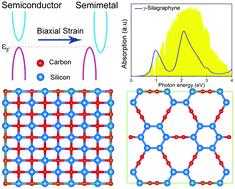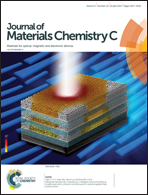Novel bonding patterns and optoelectronic properties of the two-dimensional SixCy monolayers†
Abstract
The search for new two-dimensional (2D) materials with novel optical and electronic properties is always desirable for material development. Herein, we report a comprehensive theoretical prediction of 2D SiC compounds with different stoichiometries from C-rich to Si-rich. In addition to the previously known hexagonal SiC sheet, we identified two types of hitherto-unknown structural motifs with distinctive bonding features. The first type of 2D SiC monolayer, including t-SiC and t-Si2C sheet, can be described by tetragonal lattice. Among them, t-SiC monolayer sheet is featured by each carbon atom binding with four neighboring silicon atoms in almost the same plane, constituting a quasi-planar four-coordinated rectangular moiety. More interestingly, our calculations demonstrate that this structure exhibits a strain-dependent insulator–semimetal transition, suggesting promising applications in strain-dependent optoelectronic sensors. The second type of 2D SiC sheet is featured by silagraphyne with acetylenic linkages (–C![[triple bond, length as m-dash]](https://www.rsc.org/images/entities/char_e002.gif) C–). Silagraphyne shows both high pore sizes and Poisson's ratio. These properties make it a potentially important material for applications in separation membranes and catalysis. Moreover, one of the proposed structures, γ-silagraphyne, is a direct-band-gap semiconductor with a bandgap of 0.89 eV, which has a strong absorption peak in the visible-light region, giving a promising application in ultra-thin transistors, optical sensor devices and solar cell devices.
C–). Silagraphyne shows both high pore sizes and Poisson's ratio. These properties make it a potentially important material for applications in separation membranes and catalysis. Moreover, one of the proposed structures, γ-silagraphyne, is a direct-band-gap semiconductor with a bandgap of 0.89 eV, which has a strong absorption peak in the visible-light region, giving a promising application in ultra-thin transistors, optical sensor devices and solar cell devices.



 Please wait while we load your content...
Please wait while we load your content...